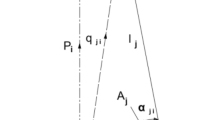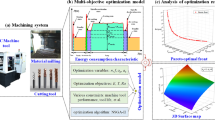Abstract
The influence of geometric errors on the accuracy of machine tools tends to attract more attention to the increasing demand for high-precision machining. In this paper, geometric error modeling and sensitivity analysis are employed to quantify the importance of geometric error for a new efficient and automatic 6-axis welding equipment. The geometric error model of the 6-axis welding equipment with 36 geometric error components is established based on Lie theory. Based on the geometric error model, the new sensitivity analysis method, in which the deviation of the welding torch pose is treated as a distance metric in SE(3), is proposed to evaluate the influences of geometric errors on the accuracy of the welding torch. And the sensitivity coefficient of each geometric error is derived by considering the basic value of geometric errors. Numerical simulations of a typical welding trajectory for intersecting pipes are conducted to analyze the sensitivity of geometric errors by the new method. The simulation results verified the validity of the sensitivity analysis method and the dominant geometric errors affecting the accuracy of the welding equipment were identified. Compared with the previous sensitivity analysis method, the proposed sensitivity analysis method considers the orientation error and position error of the welding torch simultaneously, which is more convenient and effective, and can also be applied in precision design and geometric error compensation of machine tools.











Similar content being viewed by others
References
Huang T, Li Y, Tang G, Li S, Zhao X, Xianping L (2002) Error modeling, sensitivity analysis and assembly process of a class of 3-DOF parallel kinematic machines with parallelogram struts. Sci China Ser E-Technol Sci 45:467–476. https://doi.org/10.1360/02ye9054
Schwenke H, Knapp W, Haitjema H, Weckenmann A, Schmitt R, Delbressine F (2008) Geometric error measurement and compensation of machines-an update. CIRP Ann-Manuf Technol 57(2):660–675. https://doi.org/10.1016/j.cirp.2008.09.008
Lin Y, Shen Y (2003) Modelling of Five-Axis Machine Tool Metrology Models Using the Matrix Summation Approach . Int J Adv Manuf Technol 21:243–248. https://doi.org/10.1007/s001700300028https://doi.org/10.1007/s001700300028
Fu G, Fu J, Xu Y, Chen Z (2014) Product of exponential model for geometric error integration of multi-axis machine tools. Int J Adv Manuf Technol 71:1653–1667. https://doi.org/10.1007/s00170-013-5586-5https://doi.org/10.1007/s00170-013-5586-5
Chen J-x, Lin S-w, Zhou X-l (2016) A comprehensive error analysis method for the geometric error of multi-axis machine tool. Int Mach Tools Manuf 106:56–66. https://doi.org/10.1016/j.ijmachtools.2016.04.001https://doi.org/10.1016/j.ijmachtools.2016.04.001
Díaz-Tena E, Ugalde U, De Lacalle LL, De la Iglesia A, Calleja A, Campa FJ (2013) Propagation of assembly errors in multitasking machines by the homogenous matrix method. Int J Adv Manuf Technol 68:149–164. https://doi.org/10.1007/s00170-012-4715-x
Zhang X, Zhang Y, Pandey MD (2015) Global sensitivity analysis of a CNC machine tool: application of MDRM. Int J Adv Manuf Technol 81:159–169. https://doi.org/10.1007/s00170-015-7128-9
Cheng Q, Zhao H, Zhang G, Gu P, Cai L (2014) An analytical approach for crucial geometric errors identification of multi-axis machine tool based on global sensitivity analysis. Int J Adv Manuf Technol 75:107–121. https://doi.org/10.1007/s00170-014-6133-8
Cheng Q, Feng Q, Liu Z, Gu P, Zhang G (2016) Sensitivity analysis of machining accuracy of multi-axis machine tool based on POE screw theory and Morris method. Int J Adv Manuf Technol 84:2301–2318. https://doi.org/10.1007/s00170-015-7791-x
Hong C, Ibaraki S, Matsubara A (2011) Influence of position-dependent geometric errors of rotary axes on a machining test of cone frustum by five-axis machine tools. Precis Eng 35(1):1–11. https://doi.org/10.1016/j.precisioneng.2010.09.004
Lee RS, Lin YH (2012) Applying bidirectional kinematics to assembly error analysis for five-axis machine tools with general orthogonal configuration. Int J Adv Manuf Technol 62:1261–1272. https://doi.org/10.1007/s00170-011-3860-y
Fu G, Fu J, Xu Y, Chen Z, Lai J (2015) Accuracy enhancement of five-axis machine tool based on differential motion matrix: Geometric error modeling, identification and compensation. Int J Mach Tools Manuf 89:170–181. https://doi.org/10.1016/j.ijmachtools.2014.11.005https://doi.org/10.1016/j.ijmachtools.2014.11.005
Khan AW, Wuyi C (2010) Systematic geometric error modeling for workspace volumetric calibration of a 5-axis turbine blade grinding machine. Chin J Aeronaut 23(5):604–615. https://doi.org/10.1016/S1000-9361(09)60261-2
Chen G, Liang Y, Sun Y, Chen W, Wang B (2013) Volumetric error modeling and sensitivity analysis for designing a five-axis ultra-precision machine tool. Int J Adv Manuf Technol 68:2525–2534. https://doi.org/10.1007/s00170-013-4874-4
Tang H, Duan J-a, Lan S, Shui H (2015) A new geometric error modeling approach for multi-axis system based on stream of variation theory. Int J Mach Tools Manuf 92: 41–51. https://doi.org/10.1016/j.ijmachtools.2015.02.012
Shi L, Tian X, Zhang C (2015) Automatic programming for industrial robot to weld intersecting pipes. Int J Adv Manuf Technol 81:2099–2107. https://doi.org/10.1007/s00170-015-7331-8
Li Q, Wang W, Jiang Y, Li H, Zhang J, Jiang Z (2018) A sensitivity method to analyze the volumetric error of five-axis machine tool. Int J Adv Manuf Technol 98:1791–1805. https://doi.org/10.1007/s00170-018-2322-1
Park FC (1995) Distance Metrics on the Rigid-Body Motions with Applications to Mechanism Design. ASME J Mech Des 117(1):48–54. https://doi.org/10.1115/1.2826116
Wang Y (2006) An incremental method for forward kinematics of parallel manipulators. In 2006 IEEE Conference on Robotics, Automation and Mechatronics, pp 1–5
Li J, Xie F, Liu X (2016) Geometric error modeling and sensitivity analysis of a five-axis machine tool. Int J Adv Manuf Technol 82:2037–2051. https://doi.org/10.1007/s00170-015-7492-5
Fu G, Gong H, Fu J, Gao H, Deng X (2019) Geometric error contribution modeling and sensitivity evaluating for each axis of five-axis machine tools based on POE theory and transforming differential changes between coordinate frames. Int J Mach Tools Manuf 147. https://doi.org/10.1016/j.ijmachtools.2019.103455
Murray RM, Li Z, Sastry SS (1994) A mathematical introduction to robotic manipulation. CRC press, Boca Raton
Craig JJ (2009) Introduction to robotics: mechanics and control, 3/E. Pearson Education India
Guo S, Zhang D, Xi Y (2016) Global Quantitative Sensitivity Analysis and Compensation of Geometric Errors of CNC Machine Tool. Math Probl Eng 2016. https://doi.org/10.1155/2016/2834718https://doi.org/10.1155/2016/2834718
Shi L, Tian X (2015) Automation of main pipe-rotating welding scheme for intersecting pipes. Int J Adv Manuf Technol 77:955–964. https://doi.org/10.1007/s00170-014-6526-8
Funding
The authors received research funding by the National Key Research and Development Plan of China under Grant No.2017YFB13035 and the Shandong Provincial Key Research and Development Program (Major Scientific and Technological Innovation Project) under Grant No. 2019JZZY010441.
Author information
Authors and Affiliations
Corresponding author
Ethics declarations
Conflict of interest
The authors declare that they have no conflict of interest.
Additional information
Author’s contributions
Weihua Fang was a major contributor in writing the manuscript. All authors read and approved the final manuscript.
Publisher’s note
Springer Nature remains neutral with regard to jurisdictional claims in published maps and institutional affiliations.
Rights and permissions
About this article
Cite this article
Fang, W., Tian, X. Geometric error sensitivity analysis for a 6-axis welding equipment based on Lie theory. Int J Adv Manuf Technol 113, 1045–1056 (2021). https://doi.org/10.1007/s00170-020-06527-9
Received:
Accepted:
Published:
Issue Date:
DOI: https://doi.org/10.1007/s00170-020-06527-9




